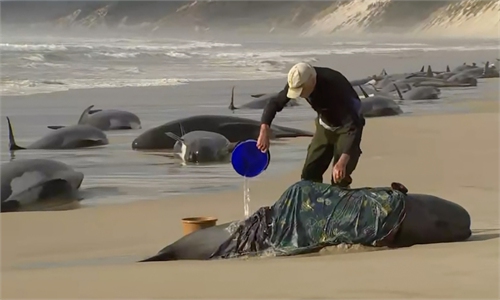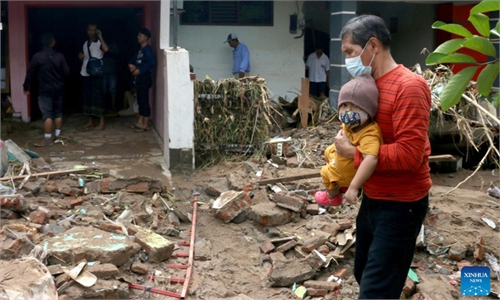Rescuers plucked more than 100 people from their roofs on Monday after a flash flood swamped a small Australian town and sent residents scurrying for safety, officials said.
A weekend downpour over much of the already-sodden southeastern state of New South Wales (NSW) sent waters rising overnight, isolating some towns and communities.
Australia's east coast has been repeatedly swept by heavy rainfall in the past two years, driven by back-to-back La Nina cycles.
Many people in the town of Eugowra, with a population of about 800 people lying 350 kilometers west of Sydney, scrambled to their roofs to flee the latest flood.
Mud-brown floodwaters have transformed the town into a murky lake dotted with the tops of buildings and trees, television images showed.
"We have had 140 flood rescues in Eugowra alone. More than 100 of these were rescues from a roof," said the state's emergency services minister, Stephanie Cooke.
Stranded residents had been taken to safety by boat and helicopter, she told a news conference.
"This is a very serious situation, not just in Eugowra but in many places," Cooke said.
New Zealand had sent 12 people to help battle the state's floods, Cooke said.
NSW's emergency services were also in contact with US and Singaporean authorities to secure further support, she said.
NSW has issued 16 immediate evacuation warnings since floods hit the central, western and southern parts of the state.
Emergency workers had carried out 173 flood rescues since early Monday, she said.
In a sign of the intensity of the thunderstorms, more than 150,000 lightning strikes had reached the ground in 24 hours across NSW, the bureau of meteorology said.
The town of Forbes, which lies a short distance west of Eugowra, had been lashed with 118 millimeters of rain in 24 hours - its highest daily rainfall in 28 years, the bureau said.
The east coast flooding disaster in March - caused by heavy storms in Queensland and NSW - claimed more than 20 lives.
Tens of thousands of Sydney residents were ordered to evacuate in July when floods again swamped the city's fringe.
Scientists believe climate change could make periods of flooding more extreme because warmer air holds more moisture.
A weekend downpour over much of the already-sodden southeastern state of New South Wales (NSW) sent waters rising overnight, isolating some towns and communities.
Australia's east coast has been repeatedly swept by heavy rainfall in the past two years, driven by back-to-back La Nina cycles.
Many people in the town of Eugowra, with a population of about 800 people lying 350 kilometers west of Sydney, scrambled to their roofs to flee the latest flood.
Mud-brown floodwaters have transformed the town into a murky lake dotted with the tops of buildings and trees, television images showed.
"We have had 140 flood rescues in Eugowra alone. More than 100 of these were rescues from a roof," said the state's emergency services minister, Stephanie Cooke.
Stranded residents had been taken to safety by boat and helicopter, she told a news conference.
"This is a very serious situation, not just in Eugowra but in many places," Cooke said.
New Zealand had sent 12 people to help battle the state's floods, Cooke said.
NSW's emergency services were also in contact with US and Singaporean authorities to secure further support, she said.
NSW has issued 16 immediate evacuation warnings since floods hit the central, western and southern parts of the state.
Emergency workers had carried out 173 flood rescues since early Monday, she said.
In a sign of the intensity of the thunderstorms, more than 150,000 lightning strikes had reached the ground in 24 hours across NSW, the bureau of meteorology said.
The town of Forbes, which lies a short distance west of Eugowra, had been lashed with 118 millimeters of rain in 24 hours - its highest daily rainfall in 28 years, the bureau said.
The east coast flooding disaster in March - caused by heavy storms in Queensland and NSW - claimed more than 20 lives.
Tens of thousands of Sydney residents were ordered to evacuate in July when floods again swamped the city's fringe.
Scientists believe climate change could make periods of flooding more extreme because warmer air holds more moisture.



